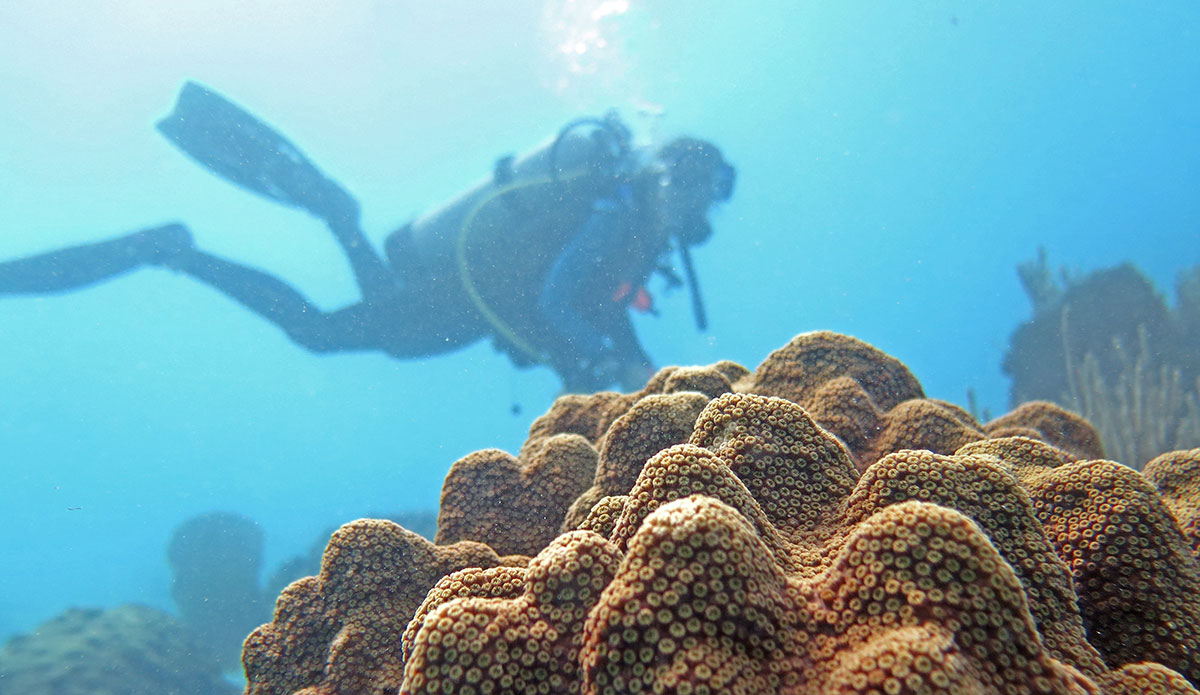
From the laboratory of Dr. Joshua Voss at FAU’s Harbor Branch campus: Orbicella faveolata (mountainous star coral) is an important reef building coral species in the tropical western Atlantic Ocean. The diver is collecting tissue samples to assess the impacts of water quality and thermal stress on the corals in Southeast Florida. HARBOR BRANCH
Quest for scientific discoveries fuels local economic resources
BY SUSAN BURGESS
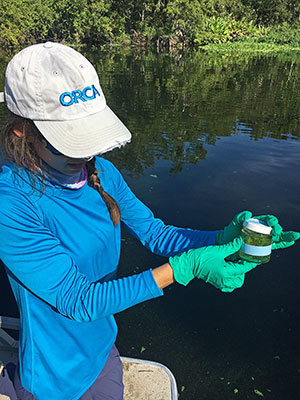
Samples of blue-green algae are collected by a researcher at the Ocean Research and Conservation Association, also known as ORCA. ORCA
Research facilities on the Treasure Coast are quietly boosting the local economy by millions of dollars while putting the area on the map with each significant discovery published by research scientists. And the better known the Treasure Coast is, the more likely it is to attract new companies and institutions.
According to the state Department of Economic Opportunity, or DEO, there were 229 researchers working in Martin, St. Lucie and Indian River counties, representing just 0.1 percent of the workforce. But they make a significantly outsized contribution because their jobs pay so well.
Helene Caseltine, economic development director for Indian River County Chamber of Commerce, said DEO figures show that their average hourly salary in 2018 was $62.03 — for an annual average salary of $129,000, without counting benefits. That translates to $29.5 million for all of the researchers combined.
The economic impact of those salaries may be around $103.5 million. Researchers also bring millions of dollars worth of grants and other funding to the Treasure Coast. And the institutions attract related businesses that supply and support them.
“Not only are they high wage jobs, they also provide a lot of education for students with internships,” she says. “And they do put us on the map to bring more companies into the area to do research or to support the research industry.”
Importantly, they and their institutions are creating jobs that pay well, boost the local economy, spread money around to suppliers and from workers’ pockets to the restaurants, shops and other businesses that keep the counties and cities alive.
The Treasure Coast had been home to five research organizations for more than 40 years when Port St. Lucie snagged Torrey Pines Institute of Molecular Studies and then the Vaccine and Gene Therapy Institute with the help of then-Gov. Jeb Bush, kicking off the city’s dream of becoming the center of a biotech cluster of research facilities. But that was not to be ... the Great Recession punched a huge hole in that plan when VGTI collapsed, along with Digital Domain, another new business in Tradition.
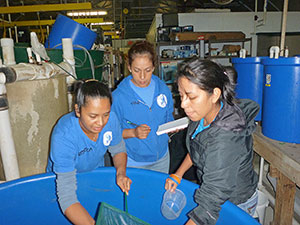
Indian River State College students take advantage of studying aquaculture at Harbor Branch. INDIAN RIVER STATE COLLEGE
But the City Council’s 12-year-old dreams of a biotech corridor in Tradition were revived in April when Torrey Pines Institute for Molecular Studies and Florida International University announced that they are seeking state and university approvals for Torrey Pines to become a part of the university. The city in late April quickly voted its support of the acquisition.
The city went through hard times when VGTI and Digital Domain folded, Mayor Greg Oravec said, but “sometimes you have to wait a long time for things to work out and succeed.”
That proved to be true. On May 28, the city entered into negotiations with Cleveland Clinic’s Lerner Research Institute for the former VGTI building. Lerner is one of the largest research institutes in the nation. Cleveland Clinic now operates the Tradition Medical Center. Lerner proposes to create a vaccine and immunotherapy institute that will become the focal point for development of therapies across the areas of cancer, neuroscience, infectious disease and allergies.
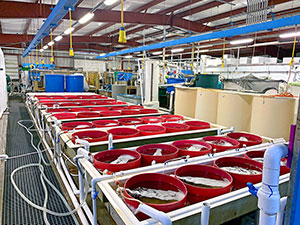
These red tanks at the Harbor Branch aquaculture facility contain juvenile fish. HARBOR BRANCH
Another international biotechnical company will co-occupy the building with Cleveland Clinic. The proposal would result in a reduction of $1.5 million in operating expenses plus property taxes that are incurred annually by the City. It is expected to create about 100 jobs with a significant economic impact, says City Manager Russ Blackburn.
U.S. Department of Agriculture researchers work on ways to combat the citrus greening disease, which is devastating the citrus industry, and to get rid of whitefly pests that eat ornamental and vegetable plants.
Researchers at the University of Florida’s Florida Medical Entomology Lab in Vero Beach look for ways to fight mosquito-borne diseases that can be deadly.
Scientists monitor and work to improve the quality of water in the Indian River Lagoon. They seek ways to grow more fish in the United States for food instead of depending on foreign countries. They want to save coral reefs from a fast-spreading disease that has attacked corals from the Florida Keys to Martin County, to find new antibiotics, to hunt for drugs to fight cancer and so much more.
Paul Wills, who specializes in growing finfish in the 30-acre aquaculture development center at Harbor Branch Oceanographic Institute in Fort Pierce, is researching a land-based tank system where the water is recirculated and where fish and plants support each others’ needs. Waste from one provides nutrients for the other.
Researchers are growing fish, shrimp, sea urchins, sea cucumbers, clams, oysters, algae and seaweed in large tanks. As they make discoveries, they pass the information on to commercial fish growers.
“Fifty percent of the seafood we eat comes from aquaculture but only one percent of that is grown in the United States,” Wills says. Harbor Branch scientists are seeking to close that gap.
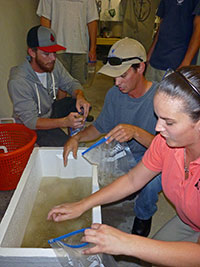
Indian River State College students go after shrimp, one of the species raised at the 30-acre Harbor Branch aquaculture facility. INDIAN RIVER STATE COLLEGE
EDUCATION
Schools encourage students to look at these careers; some high schools have specialized academies that prepare students for them. Indian River State College’s programs train budding scientists, getting them ready for jobs or apprenticeships. Universities such as Florida Atlantic University have master’s and doctoral students working at Harbor Branch Oceanographic Institute.
IRSC is working with many of the research organizations, says college President Edwin Massey. “We partner with agencies to do internships so students get real life experience to go with classroom experience.” In some cases, students become employees of the agencies with which they interned.
“We have people working in research from beach erosion to the reefs in our area to biotechnology to research on fish in the river,” he says. “It’s important to our economy and to the health and well-being of the area.”
IRSC students are engaged in research at the U.S. Department of Agriculture’s horticultural lab in Fort Pierce, at the Florida Medical Entomology Lab in Vero Beach on mosquitoes, at the Smithsonian Marine Ecosystems Exhibit in Fort Pierce on phytoplankton, and at many other places.
To provide the appropriate education for potential employees, the college creates programs that meet the needs of research organizations and other businesses already here, as well as those that might consider moving to the Treasure Coast in the future, he says. One of those programs is in biotechnology.
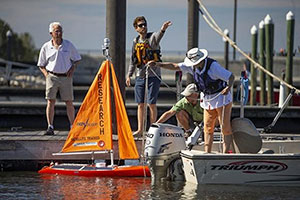
A Harbor Branch Oceanographic Institute autonomous research sailboat is placed on Lake Okeechobee to monitor the water for algae blooms. The 750-square-mile lake is the second-largest natural freshwater lake contained entirely in the contiguous United States. HARBOR BRANCH
RESEARCH INSTITUTES
FIU is not the only major university to take over a research institution on the Treasure Coast. Florida Atlantic University took over Harbor Branch Oceanographic Institute, then struggling financially, in 2007.
Among the many studies at Harbor Branch, the search for marine compounds that kill cancer cells is one of the most intriguing. Esther Guzmán, associate research professor, works on pancreatic cancer compounds. Her work has resulted in three patents.
An $801,000 grant from the Florida Department of Health is allowing Guzmán and research professor Amy Wright to search out active compounds against triple negative breast cancer.
Harbor Branch is also working on a project that may be a key to underwater national security. The goliath grouper, which weighs in at about 700 pounds, makes a characteristic low-frequency “boom” sound when approached by divers.
With a grant of up to $5 million from the Defense Advanced Research Projects Agency, researchers are working on a system that will “remotely alert authorities of incoming manned and unmanned underwater vehicles,” the HBOI website explains.
Graduate students at Harbor Branch work in marine studies in selected FAU biological and environmental sciences degree programs while earning master’s and doctoral degrees, says Harbor Branch spokeswoman Lynda Rysavy. They learn directly from scientific experts and are immersed in the research environment of the institute.
“We also have an ongoing joint study with Indian River State College on the harmful algae bacterial effect on the economy and tourism,” she says.
In recent years brown, red and green algae have been plaguing the Indian River Lagoon, the creatures and plants living in the lagoon, and the humans who live around it and use it for boating, swimming, fishing and other water activities.
Blue-green algae, actually a cyanobacteria that creates cyanotoxins, robs the water of sunlight and oxygen, kills fish, is a health hazard to animals and humans, and damages tourism industry, recreation, fishing and real estate sales. It has killed birds, wild animals and pets, and sent people to the hospital.
Florida Gov. Ron DeSantis recently created a blue-green algae task force which counts Harbor Branch Executive Director Jim Sullivan and Smithsonian Marine Station Director Valerie Paul among its five members. Their job is to identify sources of the nutrients in Lake Okeechobee that feed the algae, figure out what to do about it, prioritize their proposals and suggest state, federal and local sources of funding. They will work with the state Department of Environmental Protection.
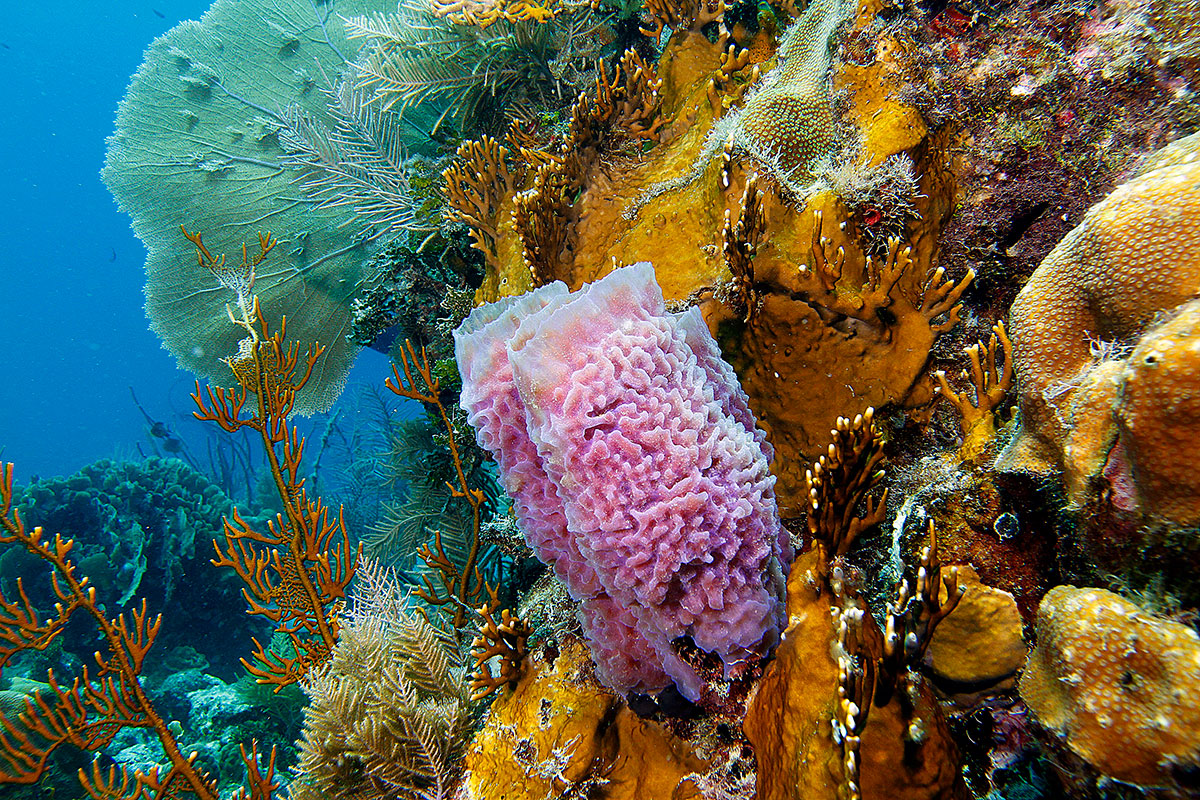
Beautiful living corals such as these can be breathtaking when seen in clear water, like the waters off the Treasure Coast. SMITHSONIAN
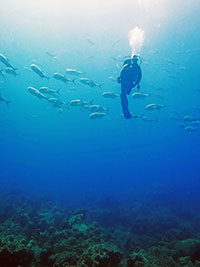
A scuba diver descends in the Flower Garden Banks National Marine Sanctuary to conduct research on coral health and ecology in support of the sanctuary’s management plans. HARBOR BRANCH
CLEAN WATERWAYS
Much research on the Treasure Coast has to do with cleaning up the water of the Indian River Lagoon, an economic engine for the area worth about $8 billion a year.
The Ocean Research and Conservation Association, better known as ORCA, led by founder Edie Widder, monitors the lagoon with devices called Kilroys, named after the famous World War II cartoon character with the long nose that peered over a fence with the caption “Kilroy was here.” They closely track water quality in the Indian River Lagoon and post it online where scientists and residents can view it in real time.
“Our current research focuses on the Indian River Lagoon and surrounding waterways,” says spokeswoman Lauren Tracy. “ORCA’s goal is to provide the information that is needed to determine what aspects of the lagoon have become unhealthy and what we can best do to put things back in balance.”
The ORCA Ecotoxicity Program conducts tests that show pollution hot spots, which can be monitored by the Kilroys to help identify pollution and its sources. “The health of the Indian River Lagoon is interwoven with the well-being of the people living on and near its shores,” she says.
“Pollution of our waterways, algae blooms and the latent accumulation of toxins in fish taken from the lagoon all have the potential to become a source of harm to the residents in our community.”
ORCA is also committed to working with budding scientists, young students who help to grow plants used for shoreline restoration, as well as engaging students and community members in a new citizen science program.
At the Smithsonian Marine Station in Fort Pierce, Blake Ushijima is working hard to stop a bacterial coral disease that is destroying the tissues of living stony coral and devastating the Florida coral reef tract.
The Marine Station also monitors water in the Indian River Lagoon. Its director, Valerie Paul, is working on ways to stem the flow of blue-green algae from Lake Okeechobee discharges into the St. Lucie Estuary which then creep into the Indian River Lagoon.
Oysters, often thought of as lowly creatures that are good to eat, play a role in cleansing the water of the Indian River Lagoon and St. Lucie Estuary. At the Florida Oceanographic Society in Stuart, where Glenn Coldren heads the oyster reef program, oyster shells are packed into net bags and placed adjacent to each other in the water to attract and grow baby oysters. Each adult oyster is capable of filtering and cleaning 50 gallons of water a day.
Thousands of volunteers have assisted in restoring over 800,000 oysters to the St. Lucie River estuary. But in a new program, researchers are trying to restore eroded shoreline using oyster reefs. Coldren said they are building planters for grasses into the reefs so the saltmarsh grass area can expand and create new shoreline. The reef tops are tilted backward to trap sediment better. While most reefs are three feet wide, the new ones are six feet wide.
In St. Lucie County, a successful oyster reef program headed by Jim Oppenborn, the county coastal resources director, relies on hundreds of adult and youth volunteers to bag oyster shells, which are then taken out and placed in the lagoon to help cleanse the water.
Oppenborn recently discovered sponges never seen before in the Indian River Lagoon. Growing on an oyster reef, they since have been identified by Harbor Branch researchers as Suberites aurantiacus. The sponge type is normally found in the Caribbean and Gulf of Mexico. A survey looking for more, and further investigation may follow.
All of this, the collaboration, the intense research focus on health, the environment, and agriculture, the involvement of schools, colleges and universities, is important to the region as well as the state, the nation and around the world.
Often hidden from the daily life of residents, research is alive and well on the Treasure Coast, growing the economy and new scientists too.
Treasure Coast Business is a news service and magazine published in print, via e-newsletter and online at tcbusiness.com by Indian River Magazine Inc. For more information or to report news email staff@tcbusiness.com
OTHER NOTABLE RESEARCH INSTITUTIONS IN FLORIDA
• Max Planck Florida Institute for Neuroscience in Palm Beach County
• SRI (formerly Stanford Research Institute) in St. Petersburg
• Mote Marine Laboratory & Aquarium in Sarasota
• Scripps Research in Jupiter
TORREY PINES INSTITUTE FOR MOLECULAR STUDIES TO MERGE WITH FLORIDA INTERNATIONAL UNIVERSITY
BY SUSAN BURGESS
With a quick vote, Port St. Lucie’s crushed dreams of a thriving biotech labs corridor in Tradition exploded into vibrant new life.
The city council on May 13 voted to support the acquisition of Torrey Pines Institute for Molecular Studies by Florida International University. FIU is on its way to becoming one of the top public research universities in the state and nation. The deal is expected to be approved by the university’s Board of Trustees and Florida Board of Governors by the end of this year.
“This will open a big door to future research in the Tradition Center for Innovation,” said Councilman John Carvelli. “It revives the old dreams of a biotech corridor. It’s an alignment of research and economic resources, education and bio-research which will be exploding in the near future.”
Torrey Pines, in the Center for Innovation next to Cleveland Clinic Tradition Hospital, is an excellent fit for FIU, the university’s Chief Operating Officer Ken Furton told the city council. The university has already leased space in the research company’s building and collaborated with it for more than five years.
FIU’s research in cancer, Alzheimer’s, Parkinson’s, addictions and infectious diseases aligns with Torrey Pines’ work, he said.
Research in two of FIU’s most important programs, the interaction of the environment with the brain and behavior, and in molecular discoveries, also align well with Torrey Pines, he said. The molecular studies program focuses on the need to find new drugs for cancer, antibiotic-resistant superbugs, neurodegenerative diseases, personalized medicine and a molecular approach to fighting mosquito-borne diseases.
SHARING BENEFITS
Torrey Pines has an enormous library of tens of millions of compounds that can be used to test whether a compound works on a particular disease. FIU and Torrey Pines will make use of this library as they conduct research.
“We will be recruiting 18 researchers over the next three years, and they will bring funding and expertise with them,” said Dr. Richard Houghten, the founder and CEO of Torrey Pines. “We will all benefit from this.”
The Port St. Lucie facility would be called the Torrey Pines Institute for Molecular Studies FIU. Houghten and most of the scientists would continue at Torrey Pines, which will be named a specialized research center.
The Torrey Pines building will be transferred to FIU under this arrangement, and when the city’s lease for the land ends in 2026, the land is expected to become theirs, said Mayor Gregory Oravec. “It’s very exciting to have an institution like FIU investing in our research corridor. We’re seeing all the pieces come together.”
